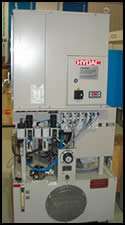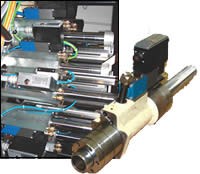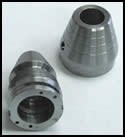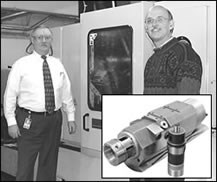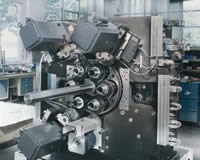Speed, Accuracy And Power In A CNC Multi World
The inherent advantages of the multi-spindle machine design remain in place within the metalworking industry. What have changed are the volume, complexity and tolerance requirements to which manufacturers must produce. Builders are responding with enhancements that keep traditional multi-spindle advantages, while dealing with the new production issues.
Most multi-spindle machine builders have made the transition from mechanical actuation to CNC axis control while increasing the flexibility of the machine tool with independent spindle speed control as well. It’s interesting to see different ways that manufacturers approach design and application of these new technologies on their machines. This article describes German builder Schütte’s approach to 21st century multi-spindle technology.
My hosts for the visit to the company’s U.S. headquarters in Jackson, Michigan, were Jim Trunk, president/CEO, and Franz Wiesbaum, technical director. Both have been around the business a long time—long enough to experience the technological sea change that has occurred in the multi-spindle machine market. I had met with Jim at IMTS and arranged this trip to find out more detail about Schütte multi-spindle technology, and how it is being applied in the market.
Featured Content
Philosophy Drives Technology
“Our first full CNC machine, the PC series, was introduced in 1996,” Jim says. “It is the platform from which we have continuously developed and applied new technology for volume parts production.”
Jim is quick to point out that slapping on new technology for technology’s sake is not how Schütte approaches the market. “For more than a century, 125 years to be exact, we have built a reputation in the industry that has become the company philosophy that drives how we choose from available technologies,” he continues. “If a particular technology doesn’t fit that philosophy, we will go a different way.”
That philosophy centers on speed, power and accuracy. The principle advantage of the multi-spindle automatic over a single-spindle machine is its ability to reduce the cycle time for making parts. “We still believe that is why a shop chooses to run a multi-spindle,” Jim says. “It’s true the kinds of work produced on the multi have changed, hence the need for newer technology, but the pursuit of cycle time reduction drives the choice of technology that we implement.”
Electrohydraulic Axes
Axis actuation is perhaps the most obvious difference between a cam-driven multi and a CNC multi. While the objective of moving the tool into the cut accurately is the same regardless of the motion control system used, there are different CNC systems from which to choose.
In 1996, Schütte made the decision to go with electro-hydraulic axis drives for all end-slide and cross-slide actuation, replacing cams. Speed, power and accuracy were the motives for this decision and fit into the company’s multi-spindle philosophy.
As the name implies, electrohydraulic drives use a combination of hydraulic fluid and electronic control to move an axis. Hydraulic fluid provides the motive force, and electronics, in the form of valve control and linear feedback, provide precision control of the motion.
Schütte constructs its axis drives as modules. Each is configured for the motion task, end feed or cross feed.
Like any hydraulic actuator, axis motion is generated using a piston and cylinder. A labyrinth seal system within the cylinder prevents leakage of hydraulic fluid. The pistons are machined with porting to allow forward and reverse motion.
A key to successful use of electro-hydraulic drives is precise control of the valve that allows hydraulic fluid into and out of the cylinder. It controls the force, speed and distance traveled.
The valve, in turn, is regulated by a processor. The valve and processor system was created in conjunction with Bosch to give finite measurement of fluid movement in the shortest period of time. In addition to the hydraulics and electronic processor, each slide is equipped with a linear scale to give actual position feedback to the processor. The digital feedback loop operates at 800 Hz, feeding back the slide position 800 times per second.
In operation, each slide’s processor is instructed via the CNC part program about its specific task in a given cycle. Once the slide has its program, it functions independently of the CNC.
“Basically, we’re measuring and controlling the precise flow of oil through the valve and into the hydraulic cylinder 800 times per second, adjusting the motion of the slide based on its programming,” Jim says. “For example, the feed rate for a slide is 0.005 ipr with a 1-inch stroke. The linear feedback is checking where the tool is compared with where it’s programmed to be. If it’s behind, the valve opens slightly. If it’s ahead, the valve is closed slightly. On each axis these adjustments are made 800 times per second.
“It’s about speed,” he continues. “This system shortens the loop and thus reduces the amount of time required to communicate between the linear scale and the motion control processor. Moreover, the slide only needs to “talk” to the CNC at the beginning and end of the cycle. Instead of inundating the CNC computer with 800 updates per second from all axes and bogging down the main processor, only two signals to the CNC are needed from each axis per cycle.”
Feed Force And Accuracy
Cutting force is another attribute that Schütte ascribes to its electrohydraulic axes. These axes give zero backlash direct linear motion. The hydraulic piston is in line with the cutting tool. The available axis thrust is 4,000 Nm, or 2,952 foot-pounds. As a safety feature, the valve control system on these units can be programmed not to exceed parameters to prevent damage in the case of a worn or broken tool.
“Multi-spindle applications have always been associated with high cutting forces,” Jim says. “Form tools and drilling operations are two prime examples of where feed power and cycle time intersect. The idea is to rough out the part as fast as possible and then bring in the semi-finishing and finishing operations. We believe the machine must be capable of power for the roughing and finesse, such as single-point turning for finishing. Electrohydraulic actuation gives us both.”
Also, the system is capable of delivering the close-tolerance specifications necessary for shops to be competitive. “Our electrohydraulic axes have a resolution of 0.1 micron. That resolution delivers a usable repeatability of 1 micron at the tool,” Jim explains. “That tolerance is necessary because of the changing nature of the work being run across the multi-spindle. Close-tolerance machining capability, along with processing flexibility, is in demand to eliminate the need for secondary operations. Customers want to drop parts off the machine complete, and that ability starts with accuracy.”
These drives generate no metal-to-metal contact, therefore no wear on the moving parts. This design provides the benefit of never having to replace a hydraulic unit because of wear. This frictionless capability is true for part processing, too.
“To complete parts in a single handling, chipbreaking and deburring become issues in the design of the cutting process,” Jim says. “In the mechanical machines, a chipbreaker cam might be used to interrupt the feed with intermittent movements in a given cycle. On our drives, a chipbreaking routine comprised of a forward and reverse feed of the slide to a point that is 30 percent from the finish stroke can be set for every 2.5 revolutions of the spindle. On one part, that chipbreaking routine translated into more than 3,500 intermittent movements over the distance of the part. In slow motion, it would look like a jack hammer. Throughout a production run, because of wear, that kind of pecking routine would be a tough duplicate using a CNC actuation system other than fluid motion.”
Spindle Speeds: Have It Both Ways
Axis feed is only one half of the cutting data needed to make turned parts. Spindle speed is the other half of the equation.
Most multi-spindle machine tool builders now offer individually programmable spindles. This innovation allows for speed and feed combinations that are optimum for the cycle being performed.
In its PC machine line, Schütte offers individually programmable spindle speeds. However, like the electrohydraulic axis slides, the company takes its own approach to programmable spindles.
“The primary spindles on our six- or eight-spindle PC machines are driven conventionally using a central gear arrangement taken off the main 30-hp spindle motor,” Jim explains. “If an application can be better produced using individually programmable spindle speeds, we can provide those on as many stations as needed.
“To run our spindles at different speeds, independent of each other, we have designed auxiliary spindle motors that can be arrayed on any of the machine’s spindles. These are 16-hp direct-drive AC motors. The auxiliary motor engages the spindle to which it is applied, which is then disengaged from the primary spindle drive motor. The auxiliary motor operates the spindle independently and runs it faster, slower, clockwise, counter clockwise, spindle stop or C-axis contour.”
Franz explains it this way: “For most applications, the first three or four stations are used for roughing operations. On these stations, spindle speed control is less critical than spindle power. For these ops, taking advantage of the 30-hp main motor in combination with the power of the electrohydraulic axis feeds makes sense. As the job moves to the upper positions optimizing speeds and feeds for single point, CSS, cross drilling and finishing operations, using the programmability and capability provided by an auxiliary spindle makes sense.” Essentially, this spindle drive setup is a blend—a powerful main spindle drive and full CNC on the stations that need it.
The auxiliary motors mount on the headstock out of the workzone and outside of the circumference of the spindle drum. As the drum indexes from one position to the next, a bull gear arrangement engages the auxiliary motor to the spindle.
A clutch disengages the spindle from the primary motor, giving it independence from the primary motor. Mounting these motors with their connections outside the circumference of the drum allows continual unidirectional indexing of the drum. While most multi-spindle applications don’t require it, any or all six or eight spindles can be set up with independent motors.
Thermal Stability Equals Accuracy
Heat is the enemy of any machine tool. As tolerance becomes tighter, multi-spindle machine builders must take thermal stability into account in the design.
As a nod to this issue, Schütte uses epoxy granite composite for the base and headstock castings in its PC line of multis. This type of base material, long used in precision grinding, has a low coefficient of expansion, which provides a thermally stable foundation for the machine.
Use of the electrohydraulic axis slide requires the use of a hydraulic oil chiller. “We thermostatically control the hydraulic oil temperature to ± 2 degrees,” Jim says. “This chiller is necessary for thermal stability within the electrohydraulic slides. We also use a cutting fluid chiller and keep it at the same temperature as the hydraulic oil.”
Extra Benefits
Ongoing, the motive to make parts complete on the multi-spindle is being adressed by machine builders. Demands for more rotating tool capability, backworking using pickoff and subspindles are the wave of the future for multi-spindle machines.
The PC machine can be configured with auxiliary equipment to accommodate a specific job and retrofitted with different options later should the job change. Three stationary backworking tools or a combination of driven and stationary tools can be brought to bear to finish parts within the multi-spindle machine.
An independent subspindle, with C-axis capability, in combination with the backworking tool slides, is literally a CNC lathe within the multi-spindle. For jobs that have “no-mar” specifications, an internal part handling system can be used to get the finished parts out of the workzone without surface damage.
Evolving Technology
Many have sounded the death knell of the multi-spindle. Naturally, Jim takes exception to this. “I see the future of the multi-spindle machine tool as different from its past, but not obsolete,” he explains. “There continues to be a demand for volume production with very short cycle times making precise complex parts. Applying CNC and its resulting flexibility to the multi-spindle while keeping speed, power and precision that differentiates the multi ensures the future. For many jobs, there’s simply no better way to cost effectively manufacture the parts.”
RELATED CONTENT
-
Why a CNC Multi-Spindle Machining Center Makes Sense for MetalQuest
An early adopter of multitasking equipment, this Nebraska contract manufacturer has taken what it feels is the next logical step to diversify by adding a multi-spindle for greatly reduced cycle times on an existing high-volume job.
-
Software Controls Chip Breaking in Thread Turning Operations
This cutting tool manufacturer has developed a software module for chip control of thread turning operations in virtually any CNC lathe, even for older machines, using specific tooling and software.
-
Shop Evolves with CNC Turning
Debbie Sommers answered a newspaper ad for a receptionist job at a South Elgin, Illinois, screw machine shop in 1980. Today, she owns the shop, an 18,000-square-foot facility with 20 employees and sales growth of 25 percent in 2017.



